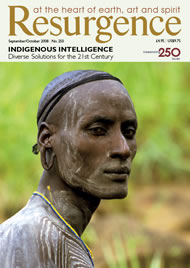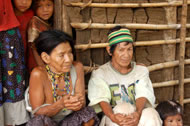RECENTLY I HAVE been studying the ethnobotany of the Guaraní people of Misiones Province in Argentina. One day I was out in the forest with a knowledgeable local man called Elvio. When we came across a flowering plant known there as guembe (Philodendron bipinnatifidum), Elvio pointed out that when this plant flowers it is an indication that it is time to plant maize and other crops because there will be no more frost. He then stated that this is how it used to be, but it is no longer as reliable as an indicator because everything appears to be changing.
Another day we were privileged to see two beautiful migrating swallow-tailed kites circling overhead. Again Elvio pointed out that the annual arrival of this bird used to be a portent that it is time to plant, but that it was not as reliable a signal as it used to be.
So even in my studies of ethnobotany today I am learning of the signs of climate change, caused by far distant peoples, from these forest dwellers who are so close to Nature. But this is only one of the threats to the livelihood of these forest people.
The first time I was in the province was to set up a conservation research and training programme for the Yaboti Biosphere Reserve. While I was visiting the governor, thirty Guaraní chiefs were camped outside his office in the central square of Posadas, the provincial capital. They were there to protest about the loss and desecration of their forest by timber companies. The next day the headlines of the local paper complained, “Governor sees gringos, but not Guaraní”.
As a result of this I met with these chiefs to explain that we had come there with the same purpose as they, to conserve the Atlantic rainforests of Misiones; and so began our collaboration. I am glad to say that a few months later, as our conservation programme developed, the governor did talk to the chiefs and later appointed a sub-
secretary in his environmental ministry to work with Indigenous affairs.
My former student, Hector Keller, has spent ten years working on the ethnobotany of the Guaraní. He was asked to carry out a survey of a particular forest area which the Guaraní were most concerned about. He found that the timber companies had paid little respect to things that are sacred to the Guaraní. For example, they were driving their heavy tractors directly over old cemeteries. Hector proposed a moratorium on logging over the 10,000 hectares of the Yaboti Biosphere Reserve that were most crucial to the Guaraní. This was accepted by the provincial government and has been in effect over the last three years. Thus an ethnobotanical study has led to better protection of a large area of forest.
Currently we continue to work on ways to improve the livelihood of these peoples through such things as ethnobotanical trails demonstrating the Guaraní use of forest to tourists, sale of their artefacts and the possible cultivation of ornamental plants. This is just one example of where the preservation of cultural diversity and biological diversity go hand in hand.
ONE THING THAT has always impressed me during my research in the Amazon region is that some of the areas with the best-preserved forest are in the Indigenous territories. In many cases a map of Indigenous reserves coincides with areas of the most biological diversity. Early in the conservation movement work on biological conservation was completely separate from work on Indigenous peoples, and I very much welcome the way in which these two fields are coming together to use the wisdom from both sources to conserve both biodiversity and culture. The wisdom of the local residents is often the way to find sustainable ways to use the forest. Two further examples of this will help to show the importance of learning from Indigenous wisdom.
In the area of the Yaboti Reserve that is under the restriction of the moratorium on timber extraction, we came across a grove of pindo palm (Arecastrum romanzoffianum). This palm ranked the most useful of all plants in our quantitative estimates of the use value of each species to the Guaraní. The fruits are edible, the leaves are used for thatch and provide a fibre to make baskets, many parts of the plant have medicinal uses, and the trunks, when felled, host beetle larvae that are a favourite food. To obtain the larvae it is necessary to fell the trees, and in some areas the forest has been rather depleted of pindo palms. However, this particular grove, on the site of an old village, was used regularly to fell trees to cultivate the larvae. The visits to this area are infrequent and only large trees are cut. The extended time between visits to harvest enables the plentiful young trees to replenish the stock and so the harvest is sustainable.
The Makú Indians of the upper Rio Negro region of Amazonian Brazil are famous for their fish-poisoning feasts at which they use plants to stun the fish and then have a lavish feast on all the fish gathered. We set out through the forest early in the morning to attend one of these banquets. After two hours’ walking at a rapid pace, we reached a small stream that looked ideal to me for the event. But the chief indicated that we should continue along the forest trail. Over the next six hours we crossed several more streams and eventually set up camp in the early afternoon beside the chosen stream. The leaves of the poison were taken from the backpacks of those who had carried them. They were placed on an improvised bridge over the stream, and several Makú men beat them until the plant juices dripped into the stream and began to stun the fish. The women were downstream of us and were soon gathering in the fish in large quantities. Our fish barbecue that evening was indeed a feast.
I asked the chief why we had to walk so far from the village over so many good streams. He replied that the first one had been used for poisoning two moons ago, the second four moons ago, and so on. He knew when each stream had been used in this way and stated that if they used their poison too often in any particular stream the fish supplies would run out. This is another good example of the sustainable use of the forest resources that protects the considerable diversity of fish in the streams.
THE CONSERVATION OF the remaining rainforests of the world is crucial to preserve the biodiversity and to retain the carbon that is fixed there. The future of all peoples of the world depends on saving forests, and the Guaraní are helping to save the largest remaining patch of the Atlantic rainforest, an ecosystem of which only 7% remains. Indigenous peoples are the key to successful conservation and sustainable use of many different ecosystems. We will fail in our mission if we do not respect and learn from the wonderful, but often threatened, cultural diversity that is still to be found in so many places.







